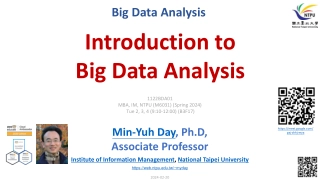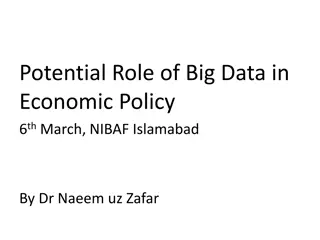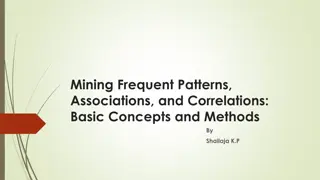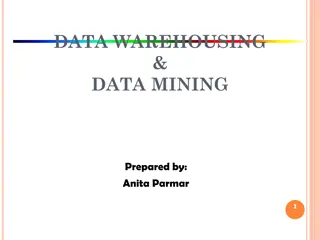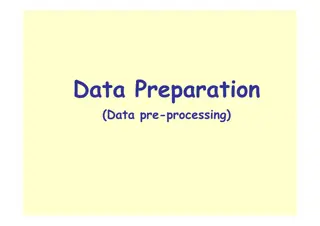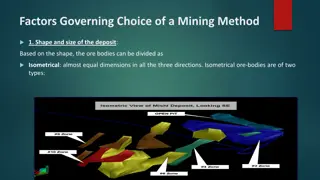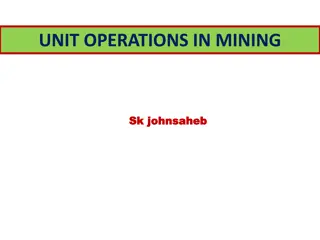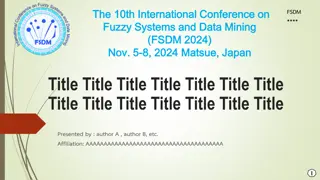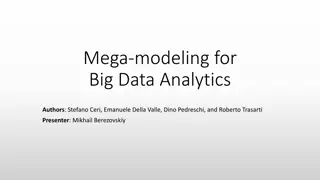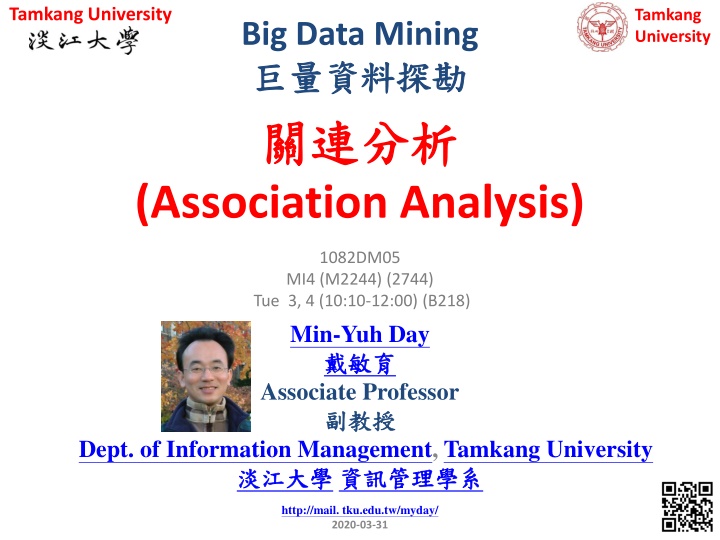
Association Analysis in Big Data Mining at Tamkang University
Explore the course syllabus for Big Data Mining at Tamkang University, covering topics like AI, Cluster Analysis, SAS.EM, and Association Analysis. Learn about data mining tasks and methods, transaction database analysis, Apriori Algorithm, and Market Basket Analysis. Gain insights into mining frequent patterns, associations, and correlations in data science.
Download Presentation

Please find below an Image/Link to download the presentation.
The content on the website is provided AS IS for your information and personal use only. It may not be sold, licensed, or shared on other websites without obtaining consent from the author. If you encounter any issues during the download, it is possible that the publisher has removed the file from their server.
You are allowed to download the files provided on this website for personal or commercial use, subject to the condition that they are used lawfully. All files are the property of their respective owners.
The content on the website is provided AS IS for your information and personal use only. It may not be sold, licensed, or shared on other websites without obtaining consent from the author.
E N D
Presentation Transcript
Tamkang University Tamkang University Big Data Mining (Association Analysis) 1082DM05 MI4 (M2244) (2744) Tue 3, 4 (10:10-12:00) (B218) Min-Yuh Day Associate Professor Dept. of Information Management, Tamkang University http://mail. tku.edu.tw/myday/ 2020-03-31 1
(Syllabus) (Week) (Date) (Subject/Topics) 1 2020/03/03 (Course Orientation for Big Data Mining) 2 2020/03/10 AI (Artificial Intelligence and Big Data Analytics) 3 2020/03/17 (Cluster Analysis) 4 2020/03/24 (SAS EM ) Case Study 1 (Cluster Analysis - K-Means using SAS EM) 5 2020/03/31 (Association Analysis) 6 2020/04/07 (SAS EM ) Case Study 2 (Association Analysis using SAS EM) 7 2020/04/14 (Classification and Prediction) 8 2020/04/21 (Midterm Project Presentation) 2
(Syllabus) (Week) (Date) (Subject/Topics) 9 2020/04/28 10 2020/05/05 (SAS EM ) Case Study 3 (Decision Tree, Model Evaluation using SAS EM) 11 2020/05/12 (SAS EM ) Case Study 4 (Regression Analysis, Artificial Neural Network using SAS EM) 12 2020/05/19 (Machine Learning and Deep Learning) 13 2020/05/26 (Final Project Presentation) 14 2020/06/02 15 2020/06/09 3
Association Analysis 4
Data Mining Tasks & Methods 5 Source: Ramesh Sharda, Dursun Delen, and Efraim Turban (2017), Business Intelligence, Analytics, and Data Science: A Managerial Perspective, 4th Edition, Pearson
Transaction Database Transaction ID Items bought T01 T02 T03 T04 T05 T06 T07 T08 T09 T10 A, B, D A, C, D B, C, D, E A, B, D A, B, C, E A, C B, C, D B, D A, C, E B, D 6
Association Analysis: Mining Frequent Patterns, Association and Correlations Association Analysis Mining Frequent Patterns Association and Correlations Apriori Algorithm 7 Source: Han & Kamber (2006)
Market Basket Analysis 8 Source: Han & Kamber (2006)
Association Rule Mining Apriori Algorithm Raw Transaction Data One-item Itemsets Two-item Itemsets Three-item Itemsets Transaction No SKUs (Item No) Itemset (SKUs) Itemset (SKUs) Itemset (SKUs) Support Support Support 1 1, 2, 3, 4 1 3 1, 2 3 1, 2, 4 3 1 2, 3, 4 2 6 1, 3 2 2, 3, 4 3 1 2, 3 3 4 1, 4 3 1 1, 2, 4 4 5 2, 3 4 1 1, 2, 3, 4 2, 4 5 1 2, 4 3, 4 3 Source: Turban et al. (2011), Decision Support and Business Intelligence Systems 9
Association Rule Mining A very popular DM method in business Finds interesting relationships (affinities) between variables (items or events) Part of machine learning family Employs unsupervised learning There is no output variable Also known as market basket analysis Often used as an example to describe DM to ordinary people, such as the famous relationship between diapers and beers! Source: Turban et al. (2011), Decision Support and Business Intelligence Systems 10
Association Rule Mining Input: the simple point-of-sale transaction data Output: Most frequent affinities among items Example: according to the transaction data Customer who bought a laptop computer and a virus protection software, also bought extended service plan 70 percent of the time." How do you use such a pattern/knowledge? Put the items next to each other for ease of finding Promote the items as a package (do not put one on sale if the other(s) are on sale) Place items far apart from each other so that the customer has to walk the aisles to search for it, and by doing so potentially seeing and buying other items Source: Turban et al. (2011), Decision Support and Business Intelligence Systems 11
Association Rule Mining A representative applications of association rule mining include In business: cross-marketing, cross-selling, store design, catalog design, e-commerce site design, optimization of online advertising, product pricing, and sales/promotion configuration In medicine: relationships between symptoms and illnesses; diagnosis and patient characteristics and treatments (to be used in medical DSS); and genes and their functions (to be used in genomics projects) Source: Turban et al. (2011), Decision Support and Business Intelligence Systems 12
Association Rule Mining Are all association rules interesting and useful? A Generic Rule: X Y [S%, C%] X, Y: products and/or services X: Left-hand-side (LHS) Y: Right-hand-side (RHS) S: Support: how often X and Y go together C: Confidence: how often Y go together with the X Example: {Laptop Computer, Antivirus Software} {Extended Service Plan} [30%, 70%] Source: Turban et al. (2011), Decision Support and Business Intelligence Systems 13
Association Rule Mining Algorithms are available for generating association rules Apriori Eclat FP-Growth + Derivatives and hybrids of the three The algorithms help identify the frequent item sets, which are, then converted to association rules Source: Turban et al. (2011), Decision Support and Business Intelligence Systems 14
Association Rule Mining Apriori Algorithm Finds subsets that are common to at least a minimum number of the itemsets uses a bottom-up approach frequent subsets are extended one item at a time (the size of frequent subsets increases from one-item subsets to two-item subsets, then three-item subsets, and so on), and groups of candidates at each level are tested against the data for minimum Source: Turban et al. (2011), Decision Support and Business Intelligence Systems 15
Basic Concepts: Frequent Patterns and Association Rules Itemset X = {x1, , xk} Find all the rules X Y with minimum support and confidence support, s, probability that a transaction contains X Y confidence, c, conditional probability that a transaction having X also contains Y buys diaper Transaction-id Items bought 10 A, B, D 20 A, C, D 30 A, D, E 40 50 B, E, F B, C, D, E, F Customer buys both Customer Let supmin= 50%, confmin= 50% Freq. Pat.: {A:3, B:3, D:4, E:3, AD:3} Association rules: A D (60%, 100%) D A (60%, 75%) Customer buys beer A D (support = 3/5 = 60%, confidence = 3/3 =100%) D A (support = 3/5 = 60%, confidence = 3/4 = 75%) 16 Source: Han & Kamber (2006)
Market basket analysis Example Which groups or sets of items are customers likely to purchase on a given trip to the store? Association Rule Computer antivirus_software [support = 2%; confidence = 60%] A support of 2% means that 2% of all the transactions under analysis show that computer and antivirus software are purchased together. A confidence of 60% means that 60% of the customers who purchased a computer also bought the software. 17 Source: Han & Kamber (2006)
Association rules Association rules are considered interesting if they satisfy both a minimum support threshold and a minimum confidence threshold. 18 Source: Han & Kamber (2006)
Frequent Itemsets, Closed Itemsets, and Association Rules Support (A B) = P(A B) Confidence (A B) = P(B|A) 19 Source: Han & Kamber (2006)
B) = P(A B) B) = P(B|A) Support (A Confidence (A The notation P(A B) indicates the probability that a transaction contains the union of set A and set B (i.e., it contains every item in A and in B). This should not be confused with P(A or B), which indicates the probability that a transaction contains either A or B. 20 Source: Han & Kamber (2006)
Does diaper purchase predict beer purchase? Contingency tables Beer Beer Yes No Yes No 100 6 94 23 77 No diapers 100 diapers 23 77 40 60 DEPENDENT (yes) INDEPENDENT (no predictability) Source: Dickey (2012) http://www4.stat.ncsu.edu/~dickey/SAScode/Encore_2012.ppt
B) = P(A B) Support (A Confidence (A Conf (A B) = Supp (A B)/ Supp (A) B) = P(B|A) B) = Supp (A B) / (Supp (A) x Supp (B)) Lift (Correlation) Lift (A B) = Confidence (A Lift (A B) / Support(B) 22 Source: Dickey (2012) http://www4.stat.ncsu.edu/~dickey/SAScode/Encore_2012.ppt
Lift Lift = Confidence / Expected Confidence if Independent Checking Saving No No (1500) 500 Yes (8500) 3500 (10000) 4000 Yes 1000 5000 6000 SVG=>CHKG Expect 8500/10000 = 85% if independent Observed Confidence is 5000/6000 = 83% Lift = 83/85 < 1. Savings account holders actually LESS likely than others to have checking account !!! 23 Source: Dickey (2012) http://www4.stat.ncsu.edu/~dickey/SAScode/Encore_2012.ppt
Minimum Support and Minimum Confidence Rules that satisfy both a minimum support threshold (min_sup) and a minimum confidence threshold (min_conf) are called strong. By convention, we write support and confidence values so as to occur between 0% and 100%, rather than 0 to 1.0. 24 Source: Han & Kamber (2006)
K-itemset itemset A set of items is referred to as an itemset. K-itemset An itemset that contains k items is a k-itemset. Example: The set {computer, antivirus software} is a 2-itemset. 25 Source: Han & Kamber (2006)
Absolute Support and Relative Support Absolute Support The occurrence frequency of an itemset is the number of transactions that contain the itemset frequency, support count, or count of the itemset Ex: 3 Relative support Ex: 60% 26 Source: Han & Kamber (2006)
Frequent Itemset If the relative support of an itemset I satisfies a prespecified minimum support threshold, then I is a frequent itemset. i.e., the absolute support of I satisfies the corresponding minimum support count threshold The set of frequent k-itemsets is commonly denoted by LK 27 Source: Han & Kamber (2006)
Confidence the confidence of rule A B can be easily derived from the support counts of A and A B. once the support counts of A, B, and A B are found, it is straightforward to derive the corresponding association rules A B and B A and check whether they are strong. Thus the problem of mining association rules can be reduced to that of mining frequent itemsets. 28 Source: Han & Kamber (2006)
Association rule mining: Two-step process 1. Find all frequent itemsets By definition, each of these itemsets will occur at least as frequently as a predetermined minimum support count, min_sup. 2. Generate strong association rules from the frequent itemsets By definition, these rules must satisfy minimum support and minimum confidence. 29 Source: Han & Kamber (2006)
Efficient and Scalable Frequent Itemset Mining Methods The Apriori Algorithm Finding Frequent Itemsets Using Candidate Generation 30 Source: Han & Kamber (2006)
Apriori Algorithm Apriori is a seminal algorithm proposed by R. Agrawal and R. Srikant in 1994 for mining frequent itemsets for Boolean association rules. The name of the algorithm is based on the fact that the algorithm uses prior knowledge of frequent itemset properties, as we shall see following. 31 Source: Han & Kamber (2006)
Apriori Algorithm Apriori employs an iterative approach known as a level-wise search, where k-itemsets are used to explore (k+1)-itemsets. First, the set of frequent 1-itemsets is found by scanning the database to accumulate the count for each item, and collecting those items that satisfy minimum support. The resulting set is denoted L1. Next, L1is used to find L2, the set of frequent 2-itemsets, which is used to find L3, and so on, until no more frequent k- itemsets can be found. The finding of each Lkrequires one full scan of the database. 32 Source: Han & Kamber (2006)
Apriori Algorithm To improve the efficiency of the level-wise generation of frequent itemsets, an important property called the Apriori property. Apriori property All nonempty subsets of a frequent itemset must also be frequent. 33 Source: Han & Kamber (2006)
Apriori algorithm (1) Frequent Itemsets (2) Association Rules 34
Transaction Database Transaction ID Items bought T01 T02 T03 T04 T05 T06 T07 T08 T09 T10 A, B, D A, C, D B, C, D, E A, B, D A, B, C, E A, C B, C, D B, D A, C, E B, D 35
Table 1 shows a database with 10 transactions. Let minimum support = 20% and minimum confidence = 80%. Please use Apriori algorithm for generating association rules from frequent itemsets. Table 1: Transaction Database Transaction ID T01 T02 T03 T04 T05 T06 T07 T08 T09 T10 Items bought A, B, D A, C, D B, C, D, E A, B, D A, B, C, E A, C B, C, D B, D A, C, E B, D 36
Apriori Algorithm C1 L1 Step 1-1 Transaction ID T01 T02 T03 T04 T05 T06 T07 T08 T09 T10 Items bought A, B, D A, C, D B, C, D, E A, B, D A, B, C, E A, C B, C, D B, D A, C, E B, D C1 L1 minimum support = 20% = 2 / 10 Min. Support Count = 2 Itemset Support Count Itemset Support Count A 6 A 6 B 7 B 7 C 6 C 6 D 7 D 7 E 3 E 3 37
Apriori Algorithm C2 L2 Step 1-2 Transaction ID T01 T02 T03 T04 T05 T06 T07 T08 T09 T10 Items bought A, B, D A, C, D B, C, D, E A, B, D A, B, C, E A, C B, C, D B, D A, C, E B, D C2 L2 Itemset Support Count Itemset Support Count L1 A, B 3 A, B 3 minimum support = 20% = 2 / 10 Min. Support Count = 2 A, C 4 A, C 4 Itemset Support Count A, D 3 A, D 3 A 6 A, E 2 A, E 2 B 7 B, C 3 B, C 3 C 6 B, D 6 B, D 6 D 7 B, E 2 B, E 2 E 3 C, D 3 C, D 3 C, E 3 C, E 3 D, E 1 38
Apriori Algorithm C3 L3 Step 1-3 Transaction ID T01 T02 T03 T04 T05 T06 T07 T08 T09 T10 Items bought A, B, D A, C, D B, C, D, E A, B, D A, B, C, E A, C B, C, D B, D A, C, E B, D C3 L3 Itemset Support Count minimum support = 20% = 2 / 10 Min. Support Count = 2 Itemset Support Count L2 A, B, C 1 A, B, D 2 A, B, D 2 A, C, E 2 Itemset Support Count A, B, E 1 B, C, D 2 A, C, D 1 B, C, E 2 A, B 3 A, C 4 A, C, E 2 A, D 3 B, C, D 2 A, E 2 B, C, E 2 B, C 3 B, D 6 B, E 2 C, D 3 C, E 3 39
Step 2-1 Generating Association Rules Transaction ID T01 T02 T03 T04 T05 T06 T07 T08 T09 T10 Items bought A, B, D A, C, D B, C, D, E A, B, D A, B, C, E A, C B, C, D B, D A, C, E B, D minimum confidence = 80% L2 Association Rules Generated from L2 Itemset Support Count L1 A B: 3/6 A C: 4/6 A D: 3/6 A E: 2/6 B C: 3/7 B D: 6/7=85.7% * B E: 2/7 C D: 3/6 C E: 3/6 B A: 3/7 C A: 4/6 D A: 3/7 E A: 2/3 C B: 3/6 D B: 6/7=85.7% * E B: 2/3 D C: 2/7 E C: 3/3=100% * A, B 3 Itemset Support Count A, C 4 A 6 A, D 3 B 7 A, E 2 C 6 D 7 B, C 3 E 3 B, D 6 B, E 2 C, D 3 C, E 3 40
Step 2-2 Generating Association Rules Transaction ID T01 T02 T03 T04 T05 T06 T07 T08 T09 T10 Items bought A, B, D A, C, D B, C, D, E A, B, D A, B, C, E A, C B, C, D B, D A, C, E B, D minimum confidence = 80% Association Rules Generated from L3 A BD: 2/6 B AD: 2/7 D AB: 2/7 AB D: 2/3 AD B: 2/3 BD A: 2/6 A CE: 2/6 C AE: 2/6 E AC: 2/3 AC E: 2/4 AE C: 2/2=100%* CE A: 2/3 B CD: 2/7 C BD: 2/6 D BC: 2/7 BC D: 2/3 BD C: 2/6 CD B: 2/3 B CE: 2/7 C BE: 2/6 E BC: 2/3 BC E: 2/3 BE C: 2/2=100%* CE B: 2/3 L1 L2 Itemset L3 Itemset Itemset Support Count Support Count Support Count A, B 3 A 6 A, B, D 2 A, C 4 B 7 C 6 A, D 3 A, C, E 2 D 7 A, E 2 B, C, D 2 E 3 B, C 3 B, C, E 2 B, D 6 B, E 2 C, D 3 C, E 3 41
Frequent Itemsets and Association Rules Transaction ID T01 T02 T03 T04 T05 T06 T07 T08 T09 T10 Items bought A, B, D A, C, D B, C, D, E A, B, D A, B, C, E A, C B, C, D B, D A, C, E B, D L1 L2 L3 Itemset Support Count Itemset Support Count Itemset Support Count A, B 3 A 6 B 7 A, C 4 A, B, D 2 A, D 3 C 6 A, C, E 2 A, E 2 D 7 B, C 3 E 3 B, C, D 2 B, D 6 B, C, E 2 B, E 2 minimum support = 20% C, D 3 C, E 3 minimum confidence = 80% Association Rules: B D (60%, 85.7%) (Sup.: 6/10, Conf.: 6/7) D B (60%, 85.7%) (Sup.: 6/10, Conf.: 6/7) E C (30%, 100%) (Sup.: 3/10, Conf.: 3/3) AE C (20%, 100%) (Sup.: 2/10, Conf.: 2/2) BE C (20%, 100%) (Sup.: 2/10, Conf.: 2/2) 42
Table 1 shows a database with 10 transactions. Let minimum support = 20% and minimum confidence = 80%. Please use Apriori algorithm for generating association rules from frequent itemsets. Transaction ID T01 T02 T03 T04 T05 T06 T07 T08 T09 T10 Items bought A, B, D A, C, D B, C, D, E A, B, D A, B, C, E A, C B, C, D B, D A, C, E B, D Association Rules: B D (60%, 85.7%) (Sup.: 6/10, Conf.: 6/7) D B (60%, 85.7%) (Sup.: 6/10, Conf.: 6/7) E C (30%, 100%) (Sup.: 3/10, Conf.: 3/3) AE C (20%, 100%) (Sup.: 2/10, Conf.: 2/2) BE C (20%, 100%) (Sup.: 2/10, Conf.: 2/2) 43
Summary Association Analysis Apriori algorithm Frequent Itemsets Association Rules 44
References Jiawei Han and Micheline Kamber, Data Mining: Concepts and Techniques, Second Edition, Elsevier, 2006. Jiawei Han, Micheline Kamber and Jian Pei, Data Mining: Concepts and Techniques, Third Edition, Morgan Kaufmann 2011. Efraim Turban, Ramesh Sharda, Dursun Delen, Decision Support and Business Intelligence Systems, Ninth Edition, Pearson, 2011. EMC Education Services, Data Science and Big Data Analytics: Discovering, Analyzing, Visualizing and Presenting Data, Wiley, 2015 45

